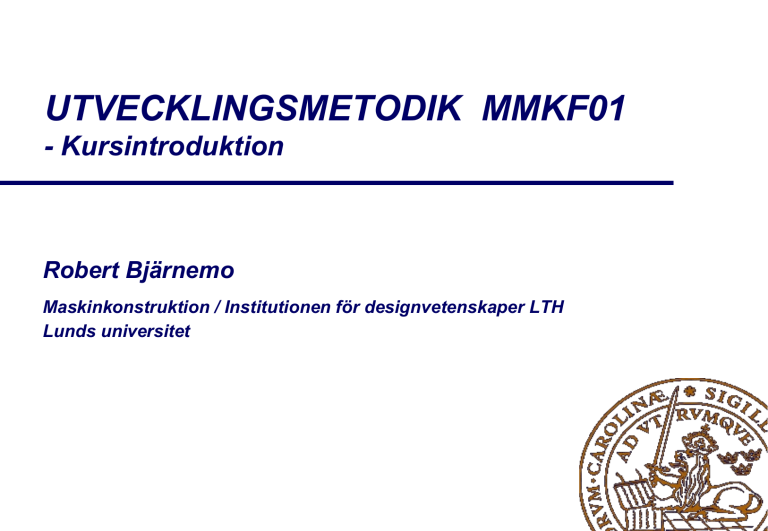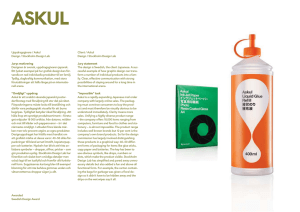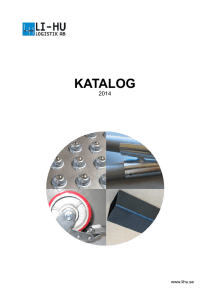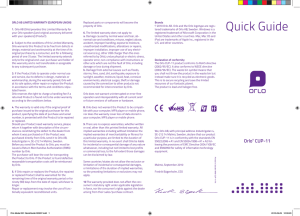Föreläsning /kursintroduktion 2013-01-21

UTVECKLINGSMETODIK MMKF01
- Kursintroduktion
Robert Bjärnemo
Maskinkonstruktion / Institutionen för designvetenskaper LTH
Lunds universitet
Kursintroduktion
Välkomna till kursen
UTVECKLINGSMETODIK MMKF01
!
Vi som ska undervisa och administrera denna kurs är:
Per-Erik Andersson , universitetsadjunkt maskinkonstruktion – projekthandledning
Robert Bjärnemo , seniorprof. maskinkonstruktion – kursansvarig, föreläsningar
Ola Carlqvist , universitetsadjunkt maskinkonstruktion avsnittsansvarig (patent)
och projekthandledning
Damien Motte , bitr. universitetslektor maskinkonstruktion – kursansvarig,
projekthandledning
Cilla Perlhagen, kursadministratör maskinkonstruktion/designvetenskaper
Kursintroduktion
INLEDNING
Denna kurs i UTVECKLINGSMETODIK MMKF01 (5 hp) ersätter en tidigare kursen med samma namn och kurskoden
MMK040 (9 hp)!
MMKF01 ges till alla M-studenter inom ramen för basblocket och fokuserar helt på produktutvecklingsprocessen.
I den tidigare kursen MMK040 , ingick ytterligare delar, bl a strategiska aspekter inom den övergripande industriella utvecklingsprocessen.
I en ny kompletterande kurs, Produktinnovation , inom specialiseringen Produktutveckling, kommer dessa delar att ingå + ytterligare fördjupningar av processen. Denna introducerades i läsperiod 1 2011.
Kursintroduktion
SYFTE
Kursen syftar till att ge grundläggande kunskaper om strategier, begrepp och metodik vid produktutveckling .
Vidare skall kursen ge övergripande insikter om grundläggande konstruktionsmetodik i form av procedurer, metoder och tekniker , som utnyttjas i metodiskt, systematiskt, konstruktionsarbete.
Notera, kursens inriktning mot metodik - det vill säga hur man går tillväga då man i den industriella utvecklingsprocessen
tar fram nya och/eller förbättrade (fysiska) produkter som ska stärka och säkra industriföretagets konkurrensförmåga och därmed också dess fortlevnad på markanden.
Kursintroduktion
KURSINNEHÅLL
Utifrån en övergripande modell över den industriella
utvecklingsprocessen, genomgås översiktligt hur ett industriföretag tar fram en för företagets strategiska mål lämpligt avpassad portfölj av utvecklingsprojekt.
I nästa del, som är kursens huvudinriktning m a p teoribildning, fokuseras på en beskrivning av produktutvecklingsprocessen och däri ingående metoder och tekniker.
Slutligen genomförs ett produktutvecklingsprojekt i ett industriföretag eller organisation.
Kursintroduktion
KURSENS GENOMFÖRANDE
Vi utnyttjar ca 20 timmar till föreläsningar och ca 25 timmar till projekintroduktion, - arbete och – redovisning.
Arbetet utförs i form av grupparbete , med 3 5 studenter per grupp. Alla i gruppen erhåller det för arbetet erhållna resultatet.
Utöver detta kontrolleras det individuella kunskapsinhämtningen genom en skriftlig tentamen.
Under kursen gång förmedlas föreläsningsanteckningar och meddelanden på kurssidan: http://www1.mkon.lth.se/UMM13.html
Kursintroduktion
KUNSKAPSKONTROLL
Då projektarbete och tentamen godkänts , erhålls slutbetyg.
Projektarbetet ger 13 - 25 poäng för godkänt resultat och godkänd tentamen 12 - 25 poäng.
Slutbetyget ges som summan av dessa poäng enligt:
Totalpoäng Slutbetyg
25 - 33 3
34 - 42 4
43 - 50 5
Kursintroduktion
ÖVRIGT
Kursen kommer att föreläsas på svenska, men … föreläsningsunderlaget avseende teoridelen (om produktutveckling) är på engelska , för att vi direkt ska kunna referera till kursboken.
För att säkerställa att ni också får ta del av motsvarande svensk terminologi, så kommer centrala begrepp att ges i
översättning till svenska i föreläsningsunderlaget.
Kursintroduktion
KURSLITTERATUR
Ulrich, Karl & Eppinger, Steven. (2012), Product Design and Development, 5th ed., McGraw
Hill, New York, NY. (4:e utgåvan från 2008 är också användbar).
4:e utgåvan från 2007 är också användbar
Kursintroduktion
KURSLITTERATUR
•
•
Utöver boken av U&E ingår:
Broschyrer i form av PDF-dokument från Patent- och Registreringsverket: Söka patent,
Det låter svårt, Så söker du patent, Skydda din design, Hur viktigt är ditt varumärke?
Forskningsartiklar – tillgängliga via Lunds universitetsbibliotek
Övningsuppgift 1
Organisera er i “bikupor” om 5- 10 studenter per kupa och gör följande:
•
Vad är produktutveckling?
•
•
Vad är konstruktion?
Vad är design?
PRODUKTUTVECKLING
PROLOG
The Industrial Development process -
Prolog
?
What is the input?
The Industrial
Development
Process
?
What is the output?
The Industrial Development Process
Material
Need
? Product on the Market
The industrial development process – one process or a number of subprocesses?
Explain each subprocess - in terms of what to accomplish during each of the processes?
The Overall Industrial Development Process
Which development projects should be undertaken by the company
Based on the project mission statement - develop and design the product-to-be
Manufacture and assembly the new or redesigned product
Material
Need
Product
Planning
Product
Development
Production
Product Innovation process
Product on the Market
Innovation according to OECD’s definition
2005
“An innovation is the implementation of a new or significantly improved product (good or service), or process, a new marketing method, or a new organizational method in business practices, workplace organization or external relations.” p. 46
“The minimum requirement for an innovation is that the product, process, marketing method or organizational method must be new (or significantly improved) to the firm.
This includes products, processes and methods that firms are the first to develop and those that have been adopted from other firms or organizations.” p. 46
R&D according to OECD’s definition 2002
“The term R&D covers three activities: basic research, applied research and experimental development ; these are described in detail in Chapter 4.
Basic research is experimental or theoretical work undertaken primarily to acquire new knowledge of the underlying foundation of phenomena and observable facts, without any particular application or use in view.
Applied research is also original investigation undertaken in order to acquire new knowledge. It is, however, directed primarily towards a specific practical aim or objective.
Experimental development is systematic work, drawing on existing knowledge gained from research and/or practical experience, which is directed to producing new materials, products or devices, to installing new processes, systems and services, or to improving substantially those already produced or installed. R&D covers both formal R&D in R&D units and informal or occasional R&D in other units.” p. 31
Introduction
PRDODUCT DEVELOPMENT
(sv. Produktutveckling)
by
Ulrich & Eppinger
Some basics
Product (sv. produkt eller vara, sistnämnda term är mest korrekt men används sällan) – is something sold by an
enterprise to a customer
– here an artifact (sv. av människan skapat konstgjort föremål)!
Products – are here constrained to those engineered, discrete and physical!
Characteristics of Successful Product
Development
pp. 2-3
The following 5 dimensions – all ultimately related to profit - are commonly used to evaluate the performance of a product development project:
Product quality How good is the product resulting from the development
effort?
Product costs – What is the manufacturing cost of the product?
Development time – How quickly did the team complete the product
development effort?
Development costs – How much did the firm have to spend to develop the
product?
Development capability - Are the team and the firm better able to develop
future products as a result of their experience with the product
development project?
From the book Product Design and Development by Ulrich & Eppinger
Who Designs and develop products?
p.3
The main functions in a company involved in the development and design of products are:
Marketing – mediates the interactions between the firm and its customers.
Design – plays the lead role in defining the working principle and the form of the product to best meet customer needs. Includes both Engineering design as well as Industrial design.
Production – is primarily responsible for designing and operating the production system in order to produce the product. Includes both
Manufacturing and Assembly.
From the book Product Design and Development by Ulrich & Eppinger
Who Design and Develops Products? p.4
Legal
Sales
Finance
Manufacturing
Engineering
Marketing
Professional
Purchasing
Specialist
TEAM
LEADER
Core Team
Industrial
Designer
Electronic
Designer
Mechanical
Designer
From the book Product Design and Development by Ulrich & Eppinger
Extended team
Duration and Cost of Product Development
p.5
From the book Product Design and Development by Ulrich & Eppinger
The Benefits of a Well-Defined Development
Process
pp. 12-13
Quality assurance - A development process specifies the phases a
development project will pass through and the checkpoints along the way.
Assuming that these phases and checkpoints are chosen wisely, following the
development process is one way of assuring the quality of the resulting product.
Coordination - A clearly articulated development process acts as a master plan
which defines the roles of each of the players on the development team. This
plan informs the members of the team when their contribution will be needed
and with whom they will need to exchange information and materials.
Planning – A development process contains natural milestones corresponding
to the completion of each phase. The timing of these milestones anchors the
schedule of the development project.
Management – A development process is a benchmark for assessing the
performance of an ongoing development effort. By comprising the actual events
.
Improvement – The careful documentation of an organization’s development
process often helps to identify opportunities for improvement.
From the book Product Design and Development by Ulrich & Eppinger
Slutligen!




